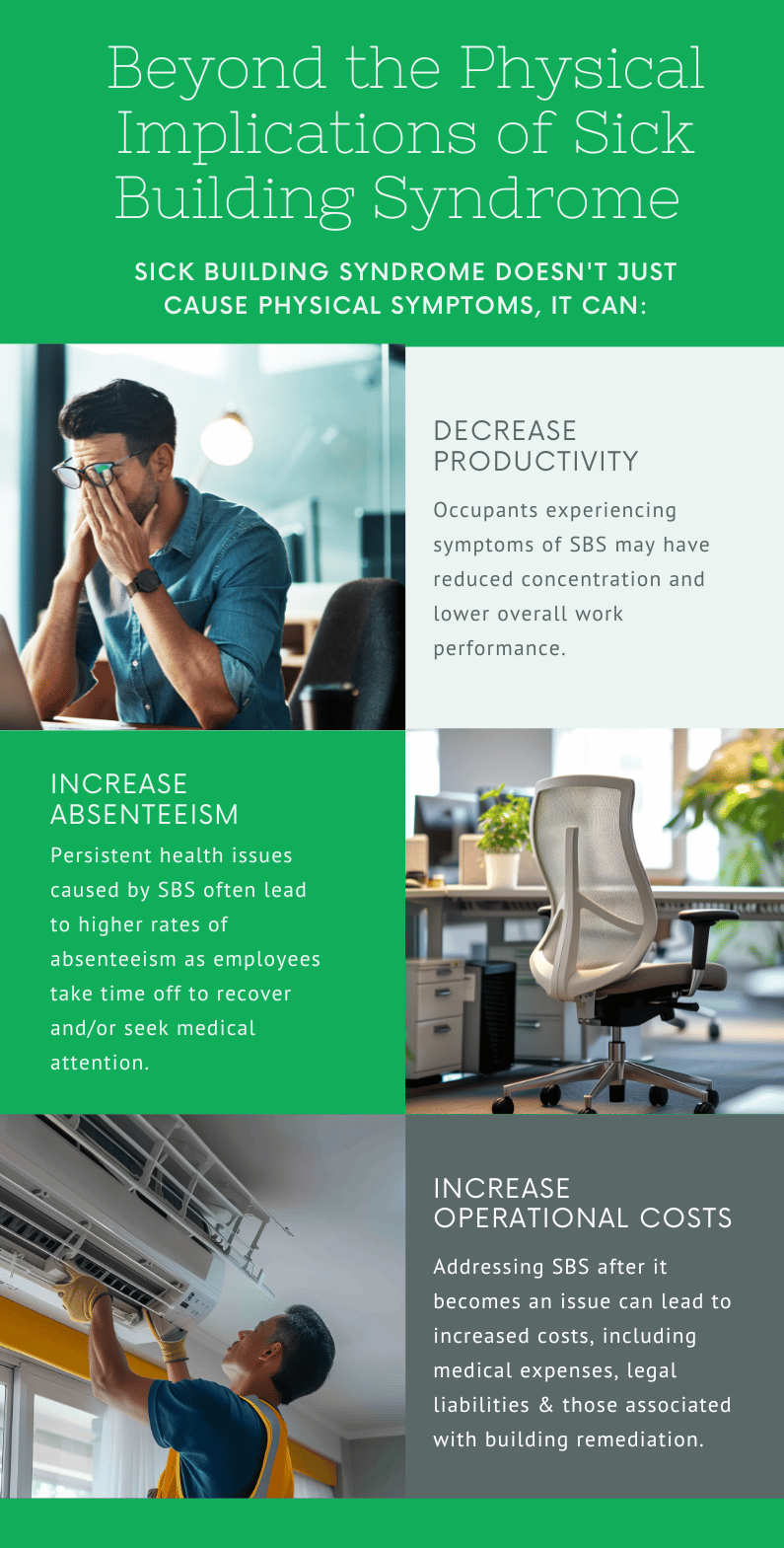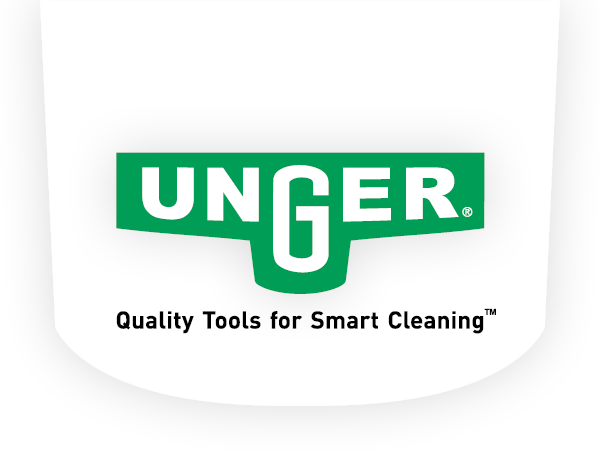NEW! Powerful Nano Filtration with Unger's HydroPower® Nano See The Product

Why Facility Managers Must Address Sick Building Syndrome
As people spend about 90% of their time indoors, there is no doubt that the quality of these spaces, whether residential or commercial, directly impacts their health. On top of building occupants facing the risk of transmitting normal seasonal viruses, poor indoor air quality, inadequate ventilation, and the presence of pollutants can lead to a condition– called Sick Building Syndrome (SBS). Sick building syndrome is a situation where building occupants experience acute health symptoms, such as headaches, respiratory problems, itchy eyes and fatigue, that seem linked to time spent in the building, but no specific illness or cause can be identified. To minimize the risk of SBS and protect the overall well-being of building occupants, facility managers can take specific steps to maintain healthier indoor environments.
Identifying Sick Building Syndrome from Other Illnesses
People impacted by sick building syndrome report symptoms such as headaches, dizziness, nausea, fatigue, and respiratory complications, all of which can be symptoms of more common viral infections.With similarities in symptoms, how do you know if a facility with SBS is causing people to get sick?
If symptoms become more prominent when in a particular building space, and diminish upon leaving, that could indicate Sick Building Syndrome. In comparison, viral illnesses often exhibit consistent symptoms regardless of location. Additionally, SBS generally affects numerous individuals within the same facility at one time, as opposed to viral infections which tend to gradually move throughout the population over time.
In addition to conducting regular indoor air quality (IAQ) assessments and HVAC system inspections to evaluate potential problems, facility managers should be aware if multiple occupants report similar symptoms while in the building. Paying attention to patterns in these complaints could signal SBS. Using an occupant survey can help track this information and identify trends. Another signal that a facility is experiencing SBS is when symptoms are widespread but don’t match those of a contagious illness, or symptoms cluster in certain parts of the building.
If concerned that SBS is the cause, facility managers can engage with environmental health experts to provide objective data around indoor air quality, ventilation and the presence of mold/allergens to determine if a contagious building or a contagious person is the underlying cause.
Identifying the Causes of Sick Building Syndrome
Understanding the common causes of sick building syndrome is important for facility managers aiming to ensure a healthy indoor environment.
- Poor Ventilation: When buildings don’t get enough fresh air, pollutants can build up causing inadequate airflow, jeopardizing the health of the indoor environment.
- Indoor Air: Harmful substances can come from various sources inside the building, such as Volatile Organic Compounds (VOCs) emitted by building materials, office equipment and cleaning products; mold, and dust.* The Building Air Quality (BAQ) Guide), developed by the EPA and the National Institute for Occupational Safety and Health, provides practical suggestions on preventing, identifying and resolving indoor air quality (IAQ) problems in public and commercial buildings.
- Inadequate Cleaning & Maintenance: Resulting in the build-up of harmful viruses and/or other pathogens that can lead to adverse effects of the occupants.
- External Factors: Environmental factors such as poor lighting and noise pollution can aid in developing SBS. Inadequate lighting can affect comfort and overall well-being while high noise levels can negatively impact health, which in turn can weaken the immune system, making people more susceptible to pollutants and allergens.

Preventative Measures for Facility Managers
To combat sick building syndrome effectively, facility managers must adopt a proactive strategy that involves:
- Improving Ventilation: The CDC guidelines recommend enhancing ventilation by bringing as much outdoor air as possible. Even slightly opening windows or doors can help. Facility managers can also ensure the HVAC settings maximize ventilation. Regular maintenance is essential to meet code requirements and achieve acceptable indoor air quality as per ASHRAE Standard 62.1. Set the HVAC system to bring in as much outdoor air as safely possible to encourage air mixing and more frequent filtration of recirculated air.
- Improve Indoor Air Quality: Adding to the issue of unhealthy indoor air and inadequate ventilation, is the introduction of airborne chemicals from building materials, furnishings, office equipment and cleaning and maintenance routines.Many cleaning supplies can release dangerous chemicals, including volatile organic compounds (VOCs). VOCs and other chemicals released when using cleaning supplies indoors contribute to poorer air quality and potentially respiratory problems, allergic reactions and headaches. For example, choosing a safer method for indoor window cleaning that requires minimal chemicals can reduce exposure to airborne contaminants. Window cleaning systems like the Unger Stingray are designed to use up to 39% fewer chemicals than conventional methods involving cloths and spray bottles. Its unique construction also includes an enclosed spray nozzle that prevents chemical particles from dispersing into the air.
- Instituting a Comprehensive Cleaning Process: To decrease the risk of SBS, facility managers should establish cleaning procedures using products that maintain cleanliness while also reducing airborne chemicals or spreading existing pathogens. Unger dual bucket mopping systems separate clean and dirty solutions to mitigate cross contamination and the spreading of germs across floor surfaces being cleaned.
By taking these proactive steps, facility managers can create a healthier, more comfortable, and productive building environment, effectively mitigating the risks associated with sick building syndrome.
Taking the Next Steps to Combat SBS
Sick Building Syndrome is not just about preventing a set of symptoms; it is about ensuring the health, well-being, and productivity of everyone who spends time within a facility. With indoor environments playing such a significant role in our daily lives, facility managers have the responsibility to maintain high indoor air quality, provide adequate ventilation, and minimize exposure to harmful pollutants.
By implementing proactive measures and staying vigilant about the common causes and signs of SBS, facility managers can foster healthier, more productive spaces for occupants. If you’re interested in discussing commercial cleaning tools that support cleaner facilities with healthier occupants, contact Unger today to learn how our innovative solutions can help you achieve your goals.

